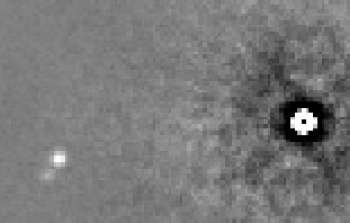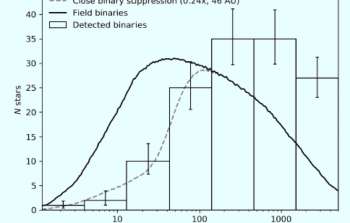sci19069 — Announcement
SOAR Follow-up of TESS Exoplanet Candidates: most exoplanets don't “like” binaries, but some do!
November 18, 2019
The Transit Exoplanetary Survey Satellite (TESS), launched by NASA on 18 April 2018, scans the whole sky, looking for planets around bright stars by detecting the small light loss caused when a planet transits its host star. Thousands of transiting exoplanets have been discovered from space and from the ground. The strength of TESS, however, is in its uniform survey of bright stars, which are most interesting for the detailed study of exoplanets.
Binary stars present a problem for transits because (i) the light of the companion dilutes the depth of the observed transits, which leads to an underestimate of the planet’s radius, and (ii) if the faint companion is an eclipsing binary, it can mimic exoplanet transits around the main star, producing a false-positive detection. Screening all exoplanet host candidates for binary companions with high-angular-resolution imaging is therefore an essential complement to TESS observations.
As TESS began its survey by scanning the southern sky, the High-Resolution speckle camera at the 4.1-meter SOAR telescope was the natural choice for screening hundreds of TESS objects of interest (TOIs) for close companions. The team led by Carl Ziegler (University of Toronto), which includes NSF OIR Lab astronomers A. Tokovinin and C. Briceño, began the observations in September 2018, soon after the very first TOIs were announced. These observations are highly automated, covering up to 300 objects per night. The data were processed within a week and posted promptly on the TESS follow-up web site. Several papers on TESS exoplanets have used these observations. It turns out that about 20% of the 542 TOIs observed to date at SOAR have companions within 3 arcseconds, only a fraction of which were previously known. The first Figure shows the pair of faint stars, separated by 0.17”, accompanying TOI 612 at a distance of 2”, as revealed by SOAR.
The results of the TESS follow-up campaign at SOAR, which have been accepted for publication in the Astronomical Journal (Ziegler et al. 2019), are available online. Apart from their purely technical utility (correction of transit depth and false positives), the large and uniformly observed sample of TESS exo-hosts revealed interesting statistical trends (see the Figure below from Ziegler et al. 2019). The frequency of binary companions with separations below ~50 au is reduced by a factor of 4 compared to similar stars that do not host transiting planets (a similar trend was found earlier by A. Kraus et al. for Kepler exoplanet hosts). Apparently, the existence of a close binary companion suppresses (albeit not completely) the formation of planets.
Even more intriguingly, the SOAR survey revealed the excess of wide binaries among TESS exo-hosts. However, the surplus of wide companions is found almost exclusively for stars hosting “hot Jupiters” (massive planets on tight orbits, like the one orbiting 51 Pegasi). This finding points to the relationship between binary systems and the properties of their planets. It is currently believed that hot Jupiters formed at large distances from their stars (like Jupiter in our Solar System) and later migrated inward to their present-day tight orbits. Wide binary companions could have played a critical role in promoting the migration of hot Jupiters, e.g., by destabilizing other planets that could have thrown the hot Jupiters into close orbits.
Contacts
Andrei Tokovinin
NOIRLab
About the Announcement
| Id: |
ID
sci19069
|

